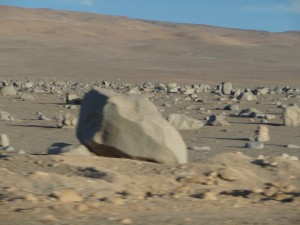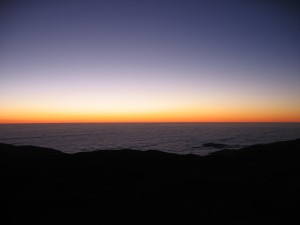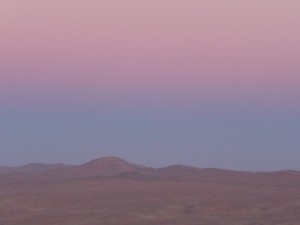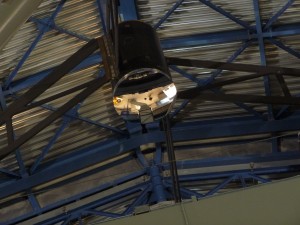X-Shooter goes on sky – 5th episode

X-Shooter goes on sky again and again (Nights 2, 3 and 4)
January 19, 2009
Sergio Bertolucci, Director for Research at CERN, comes to ESO to talk about LHC
April 30, 2009We are now running our last night. It is very strange, since it looks like we had arrived only yesterday. Thoughts and images start to be confused and I am at a loss in trying to put them in the right order. While doing this, memories begin to emerge… On the way to Paranal, after leaving Antofagasta and taking the Panamericana, for quite some time the road is flanked by a very impressive landscape. Thousands of stones are spread all over the land. Their edges are smoothed, as if they were grinded by wind and dust for a long, long time. I have never been on Mars (at least not yet) but, had I been there, they would certainly remind me of the red planet. Indeed, the landscape looks very similar to those pictures sent back by the Pathfinder.
Once I was told that these stones have been brought up by the strong earthquakes that torment this area. I am not sure this is true, but the view of these stone fields is fascinating. In some way it gives you a proper introduction to the atmosphere you will be soon breathing in Paranal. Even though coming from Europe you have traveled some 15,000 km, it is the last 200 km that make the difference.
It is during those two hours that you really leave the civilization and you abandon, in a sense, the rest of mankind. It is a kind of a last frontier, which brings you somehow closer to the stars.
When the sun sinks into the sea of clouds, it is like a veil would dissolve and reveal the beauty which the glare of the Sun hides during the day. It is a show that has been repeating for countless years but has not lost its fascination. It is not just the fact in itself. It is rather the memories that it brings back, the heritage of all past stargazers, back to the most ancient steps of mankind. It is, somehow, the marriage between heaven and earth that renovates at each sunset. On top of this, being here at Paranal, there is something more. The remoteness of the place and all the technology that is deployed here tend to enhance the way you perceive it. I would not know how to explain you why it is so. It has probably to do with the feeling of being in an exceptional, privileged standpoint, that gives access to views that are precluded to most people.
Tonight, our last night, Joel and I came up to the summit a bit earlier than usual, because we wanted to see the sunset from the summit. From up there you can see the sun disappearing below the horizon defined by the sea of clouds. When we arrive, the western edge of the platform where the VLT sits, is full of people, all eager to see the green flash… I leave them there, because I am more interested in looking into the opposite direction. After walking in between the giant domes, I reach the eastern edge of the platform. And, yes, what I am looking for is there, in all its magnificent, discrete, simple beauty. It is the shadow of the Earth.
Some time before the actual sunset, from the top of the mountain, looking to the west, you start seeing the shadow of Paranal projected into the desert. Slowly, it becomes longer and longer, until it touches the sky. At this point, a larger shadow starts to appear, covering a good portion of the western horizon. It is now the Earth itself casting a shadow on its own atmosphere. It appears as a blue, darker strip, which you can tell very easily from the typical reddish twilight colors. But it is a very delicate effect, that few care to see and even less know it exists. Fascinating, all the more. During my previous visit I obtained time-lapse photography of the phenomen. You can have a look here. The shadow of the Earth gave me also the inspiration for a show I put together with an actor (Massimo Somaglino) and a jazz piano player and composer (Glauco Venier). Here I only tell you it’s called L’Ombra della Terra (Earth’s Shadow) and it has been premiered last year in Italy. It has been a great experience. I’ll tell you more about it in a dedicated post.
It is now almost two in the morning and we are observing a quasar at a redshift of about 5.5. It is a very faint source and we want to push X-Shooter at its limits. So far we have done only bright staff, like SN1987A and Eta Carinae. By the way, the spectrum of 1987A was very interesting, with lots of narrow emission lines.
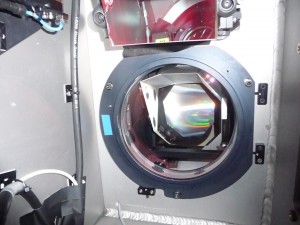
The echelle grating of X-Shooter seen through the cross-disperser prism. The colored bands are the emission lines produced by the UT3 dome lamps.
A spectrum, especially in its original two dimensional form, is always a bit of a disappointment for a non specialist. This is even more true for spectra produced by instruments like X-Shooter, which make use of a so called echelle grating as a dispersive element. In that case, the spectrum is a series of curved strips (called orders), each of them covering a rather short wavelength range. This has the advantage that one can pack a wide spectral range with a high resolution into the detector. In a few words, the echelle grating, coupled to the cross-disperser, splits the spectrum in a number of segments, slightly overlapping, and places them on the detector one after the other. Without this trick, in order to have the same resolution, one would have to use an unrealistically long detector.
Of course, as usual, it is much easier to figure out things looking at a figure rather than reading many lines of text. So, have a look at the photo to the right, which shows the 2D spectrum of SN1987A obtained a few nights ago with X-Shooter. The curved bright lines within each single order are the portions of the continuum spectrum of the object. On top of it, you can see short, narrow, almost horizontal segments. Those are the emission lines produced by the night sky, known also as nightglow. In the blue side (left) there are only a few of them, while as wavelength increases (to the right), their number increases too. This is why the night sky is brighter in the red than it is in the blue (that is also another very good reasons to build blue-sensitive instruments). Most of the nightglow emission lines you see in this spectrum are produced by transitions in the rotational-vibrational states of the OH molecule. In the near-infrared this emission produces a forest of lines and becomes very strong. If you look now more carefully at the spectrum, you will notice some bright spots, right on top of the continuum. At variance with the night sky emission lines, which cover the full width of the spectrograph slit, those from the SN ring are more confined in space.
The most prominent one, which you can see slightly to the left and to the top of the image center, is the famous H-alpha line of Hydrogen. For a detailed analysis, the night sky spectrum will have to be subtracted and the spectrum of the object extracted into a one-dimensional tracing. When this is done, the real scientific analysis can start. The bright dots you see all over the spectrum are cosmic rays, which hit the detector during the exposure (that lasted half an hour). This is typical of long exposures.
While I was writing these notes, the spectrum of the quasar came out. Joel is excited, since indeed we can see, in between the night sky lines, a weak emission line which undoubtedly comes from the source. Honestly, when we started the exposure we were quite skeptical. But we have to take it back: X-Shooter is indeed a very efficient instrument… During one of the previous nights, Elena had derived the absolute efficiency of the instrument, which is practically the ratio between the photons which reach the telescope and those which are revealed by the detector. This ratio is of course always lower than one and, for spectrographs of this kind, it can be as low as a few percent. X-Shooter is extraordinarily efficient: at the central wavelengths of the UV and Visible arms the efficiency is larger than 35%, and the instrument can reveal photons down to 3030A. I had seen spectrographs reaching 3100A, but never this blue!
We will be observing now a few other targets and visit again Eta Carinae before the night is over, since there is some activity going on there. Then, we’ll take the car and go down for breakfast. Or should I rather call it dinner? Well, I do not know… It seems to me yesterday when with Hans and Joel we were having a beer at the Zurich airport, waiting for the flight to Santiago. And now it is already time to leave… It has been a great week, under all points of view. The company was excellent and we had a very good time. This afternoon, walking on the VLT platform, Paolo (Santin) told me that he loves this place and he will certainly miss it.
But X-Shooter will have to go through further commissioning and science verification activities. Don’t be sad, Paolo. We’ll come back soon.
Hasta pronto, Paranal!


